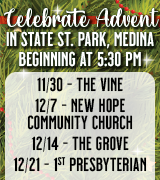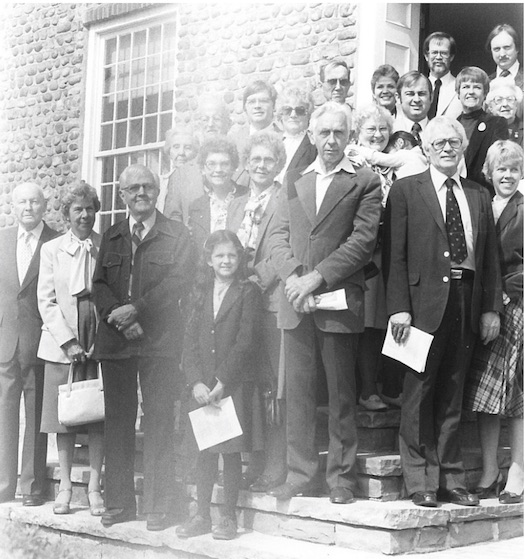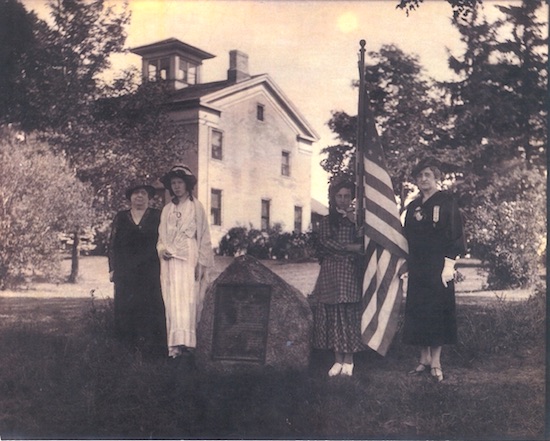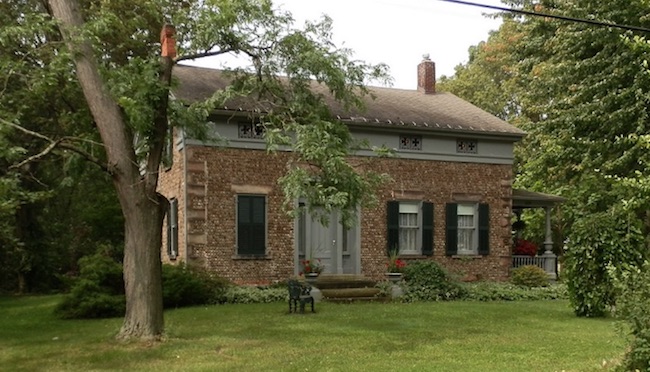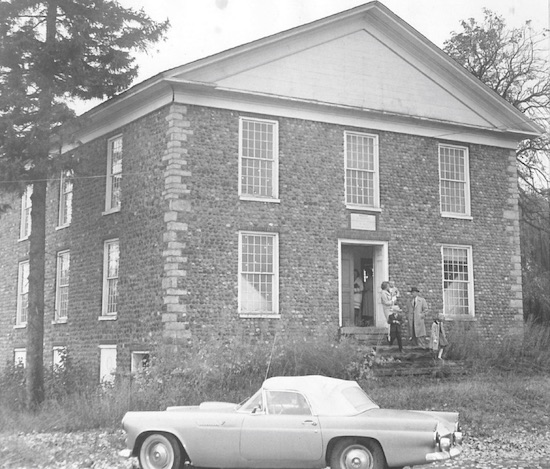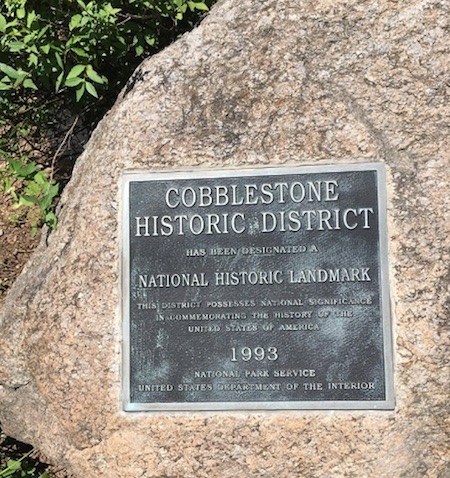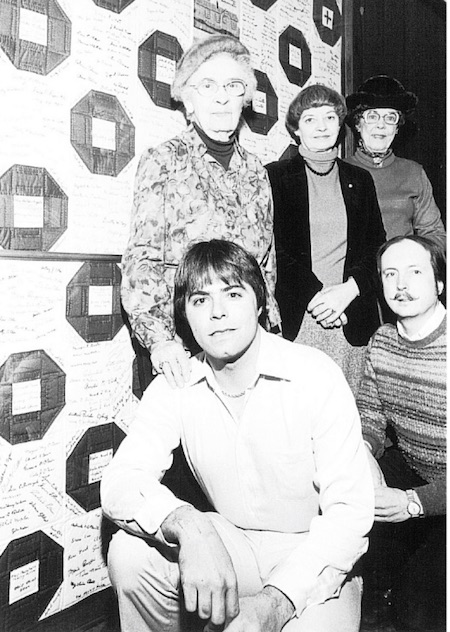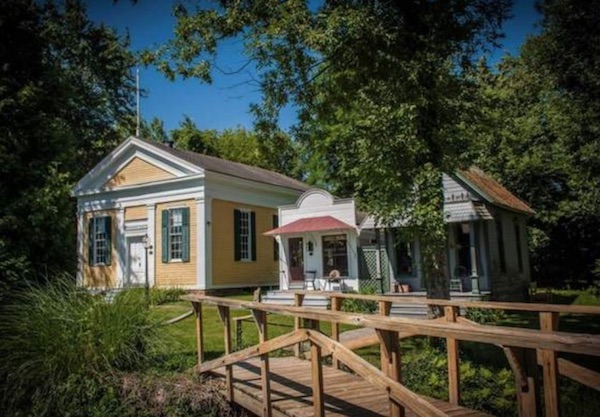Historic Childs: 3 generations of the Lattin family preserve local history, Part 1
By Doug Farley, Cobblestone Museum Director
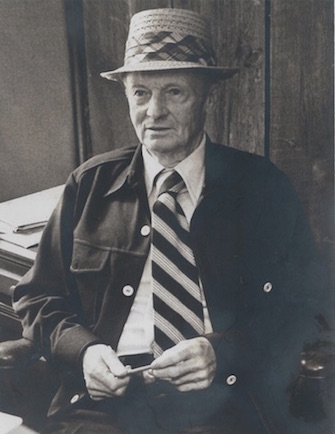
Cary H. Lattin (1898-1988) began a family legacy of historic preservation that continues today.
GAINES – The Lattin family name is well known to anyone with an interest in local history. Three generations of Lattins have lived and worked here with a mission to preserve the stories, architecture and culture of our shared history in Orleans County.
Adrienne (Lattin) Kirby, current Town of Gaines Historian, has been preceded by her father, C.W. (Bill) Lattin, former Cobblestone Museum Curator and Orleans County Historian; and her grandfather, Cary Lattin, seen here circa 1980, who also served as Orleans County Historian. The Lattins come from a long line of pioneers that have been present in the community for eight generations.
Adrienne shared recently that history, and historical preservation, were literally in her blood, Lattin blood. After all, she was the child of Bill Lattin and grandchild of Cary Lattin. From her youngest days she would eat, drink and sleep history. Her childhood home on Gaines Basin Road was built in the 1820s.
Adrienne said, “The house had the original plaster walls and was painted historic colors.”
She reflects on life surrounded by antiques and objects from a bygone era. Adrienne’s father, Bill, was working as curator of the Cobblestone Museum at that time, and she recalls that she was always being drawn into his work, sometimes by request, and sometimes because, “Dad pressed me into service.”
For Adrienne, born in 1974, seen here, front right, reflected that while some kids would be playing tag or hide-and-seek, she might have been cleaning the historic windows in America’s oldest Cobblestone Church.
“Though I did wash a lot of windows in the church, my sister, Allison, and I played a lot, too,” Adrienne said. “When we played ‘house,’ it was in the Ward House. When we played ‘school’ we had a real schoolhouse to play in. Most kids probably don’t play ‘church’ but we had one to play in, so we did.”
Others assembled here in June 1982 for the dedication of the John Brush plaque in the Church lobby include: Front Row (Left to Right): Three representatives from First Universalist Church of Rochester, Adrienne Lattin, age 7. Row Two: Signe Maine, Melva Roberts, Elton Roberts, Mr. and Mrs. Jack Brush. Row Three: Florence James, Lee Maine, Rev. Richard Hood, Dorothy Pratt, Jean Bistoff holding her granddaughter, Joani Loss. Row Four: John Pratt, Lenore Houck, Richard Hoffman, Betsy Hoffman, Ruth Needham. Back: Dr. Douglas Houck and C.W. (Bill) Lattin.

Adrienne Kirby speaks during an unveiling ceremony for a sign for Beardsley Creek on July 28, 2018.
By the age of 9 years old, Adrienne could be found helping her father by giving museum tours. “I started by giving tours in the Church where Dad could keep an eye on me,” she said. Soon, Adrienne was leading Museum tours, on her own, up the road to the National Landmark Cobblestone Schoolhouse.
“When you think about it, no one gave it a second thought, a third grader leading total strangers alongside a busy state highway to a destination 2/10s of a mile away,” she said. “Times were different then!”
Adrienne said she really enjoyed giving Museum tours. She recalls that one group of Museum visitors was so pleased with their tour, that they gave her an “E-T” shirt. The guests told Adrienne that she was “Just so darn cute!” Another fond memory was, because she was “always at the museum,” at lunchtime, her dad would give her a dollar and send her to the H&A next door to buy a Twinkie and a comic book. At 7 years old her favorite comic book was “Richie Rich,” or “Mad Magazine.” “But if I bought a Mad Magazine, I couldn’t buy a Twinkie because I wouldn’t have enough money!” Sounds like a valuable life lesson was learned.
When Adrienne was about 9 years old, she recalls that her father took her up to the Cobblestone Schoolhouse and showed her how to use a riding lawn mower. She said, “This was terribly exciting to me, because a riding lawn mower was practically like DRIVING! After instructing me on use of the pedals and so forth, he instructed me to mow the back lawn. Giddy with all the possibilities driving allowed me, my father watched me as I proceeded to make a figure 8 and make all sorts of mazes and cool designs in the grass. He never said a word, but I didn’t get to use the riding lawn mower again!” However, Adrienne did mow a good deal of lawn behind the church and on Route 98 (with a self-propelled mower). Adrienne also remembers what a “pain in the neck” it was to use the old canister Electrolux to vacuum in the Cobblestone Church. She said, “I was so happy when some kind soul donated an upright vacuum cleaner to the Museum.”
Adrienne also enjoyed the Cobblestone Museum’s annual Flea Market. She said, “There was so much history to be seen and touched.” The pie booth held in the old railroad flagman’s shanty on the Museum grounds was another favorite. Adrienne added, “Over the course of two summers, my Dad taught me how to use the printing press at the Print Shop on Route 98.”
Adrienne’s grandfather, historian Cary Lattin, died when she was in 7th grade. She said, “My dad and grandfather both enjoyed telling stories. But, there was a big difference. Dad always stuck to the facts, but Grandpa was more prone to add some tall tales.”
Following college, Adrienne lived and worked for a brief while in Albany before returning to her hometown to live, work and raise a family. In 2012 she and her husband, Justin Kirby, purchased the old Proctor homestead in Childs, one of its oldest residences, once owned by the community’s founding father, John Proctor. Adrienne said, “Buying this house was the opportunity of a lifetime! We had been living on Ingersoll Street in Albion, but it was just too small. And, it was in the Village. Not that villages aren’t nice, but it was not Gaines. There’s just an amazing appeal to the land of my roots.”
The John Proctor House is seen here in this image from October 12, 1935 on the day of the dedication of the historic marker to honor Proctor. Katherine Rowley, first Orleans County Historian, is on the far left. This is probably the last photo of her, as she passed away three days later. Next to Miss Rowley is Barbara Balcom, and the girl holding the flag is Elda Barnum, both great-great-grandnieces of John Proctor. The woman at the far right is Grace Bliss, then Regent of the Orleans Chapter, D.A.R. The historic marker, seen here, was originally placed on the west side of the Proctor House. About 15 years ago, the marker was moved to the east side in order to make it more visible to the public.
In 2018, Adrienne said she got her “dream job.” She was appointed to be Town of Gaines Historian. The job itself is part time, but it allows her to pursue her love for local history and still take care of her young family, who need her help with homeschooling and much more. While on the job, she has really enjoyed exploring the community’s connection to abolition. She said, “There are many primary documents. It’s like solving a mystery!” Adrienne is particularly interested in the Robert Anderson papers. She said, “Anderson was a possible Liberty Party candidate for Lt Governor in 1848.”
Adrienne said she enjoys her role as Historian, because it allows her time to write. “The town has been very fortunate that it has had historians who like to write, like Cary and Bill Lattin, Howard Pratt, Dee Robinson, and Al Capurso.” She said she finds their historical research and writing fascinating. Adrienne reflected, “Cary Lattin and J. Howard Pratt used to enjoy some friendly rivalry when it came to history. Mr. Pratt would say, ‘My family came to America on the Mayflower,’ and Grandpa would reply, ‘Well one of my ancestors was Native American, so who was here first!’”
Adrienne also explained that as Gaines Historian, she is glad she has been able to digitize many old records. “I’ve been working on the Congregational Church records. The Church recently re-discovered some of their old records. It’s helping me a lot with my research on abolition. Many churches split at that time over the subject of slavery.” Adrienne shared, “Even after 46 years, I’m still learning new things I hadn’t known about.”
Adrienne’s advice to everyone: “Write things down. Put names on the back of pictures. Write down the family stories. If you don’t, so much history is lost forever.”
Bill Lattin couldn’t be prouder of both of his children, Adrienne who serves as Town of Gaines Historian and Allison who works in Albany with the NYS Office of Parks, Recreation and Historic Preservation. History was certainly in Bill’s blood, too. His father, Cary Lattin, served as Orleans County Historian from 1957-1975.
Cary lived in a cobblestone house on Gaines Basin Road that was built in 1842. Four generations of Lattins have now lived in that house, culminating in Bill’s occupancy. Cary enjoyed a membership in the Sons of the American Revolution, a lineage based organization whose members all descend from Revolutionary War patriots. Cary got started in the job of County Historian, following the death of his friend, Joe Achilles, who served in that role before him. Cary became the fourth person to serve in the role of Orleans County Historian, following in the footsteps of Katherine Rowley, then by Theta Brown and Joe Achilles.
Owning a cobblestone home is a good start on becoming an “historian.” Most anyone who has owned a cobblestone home will tell you it’s a love-hate relationship. They love the history, character, beauty and charm, and also dislike the cold winters, hot summers, and continual need for vigilance with the historic mortar. Cobblestone home owners enjoy telling others about the history of their residence. The next logical step is telling the story of the community and families where your house is located. So, the next thing you know, you’re a historian.
Cary Lattin used his time in “office” to write a weekly column entitled, “Out of the Past,” that was printed in several local newspapers. Early in his appointment as County Historian, he became involved with a group of men and women, largely led by history teacher, Robert Frasch, who formed a grass-roots group to explore and do something about the increasing decay and destruction of 19th century cobblestone buildings.
The group’s initial interest was the former Cobblestone Universalist Church in Childs. Weekly services in the church had ended about 70 years earlier. The church is seen here in this 1960 view, prior to restoration. Note the iconic church tower is missing; it was torn off the building in 1919 and wasn’t replaced until 1964.
At the time of this photo, the lower level of the church was being used to store cabbage, the roof was deteriorated, windows broken, terrace missing, and the historic mortar pointing was in rough shape. Without a doubt, the building was destined for destruction without a concerted effort to save it.
Cary Lattin and Robert Frasch joined with the others to create the necessary momentum, and the Cobblestone Society was formed in 1960. He served on the first board of directors, a role he held for many years.
Over the ensuing years, the Cobblestone Society grew in size and mission to save other local cobblestone buildings which in 1993, became the basis for designation as the Cobblestone National Historic Landmark District. This national recognition honors select properties that not only demonstrate an importance to local history, but also tell a story important to the history of our nation.
Cary Lattin was followed in his role as County Historian by Arden McCallister who became the county’s fifth County Historian. Cary’s son, Bill, picked up the torch for historical preservation, too. He lives in the family’s cobblestone house, and accepted a part time job as curator of the Cobblestone Museum in 1971, later expanded to full time. It was a job he held for 40 years, until 2010. During that period, he followed in his father’s footsteps as Orleans County Historian in 1979, and served in that role for 35 years until 2014.
Matt Ballard followed Bill as County Historian and Catherine Cooper followed Matt, becoming the eighth County Historian in the county’s history.
An attempt to list all of Bill Lattin’s activities and accomplishments in the field of historic preservation would be a challenge for sure, if not impossible. Suffice it to say, we will scratch the surface. Here we see Bill (lower right), beside Mark Tillman, in 1983, with the Signature Quilt that was mounted for display at the Village Inn. Behind the men are (left to right) Josephine Howard, Beverly Leigh and Marcia Hart who were in charge of embroidering over 700 names on the quilt. The quilt and its collection of signatures of local individuals from the past is still on display at Tillman’s.
Bill enjoyed the many years of fellowship with other historians, and the thousands of visitors he greeted at the Cobblestone Museum complex, seen here with the Orleans County Municipal Historians circa 1982.
Those present included: Front row (Left to Right): Dee Robinson, Gaines Deputy Historian; Ceil White, Medina Historian; Virginia Cooper, Yates & Lyndonville Historian; Helen McAllister. Second Row: Arden McAllister, Orleans County Historian retired; Eleanor Wilder, Village of Albion Historian; Betsey Hoffman, Carlton Historian; Alice Zacher, Shelby Historian; Bill Lattin, Orleans County Historian. Back Row: Alan Isselhard, Clarendon Historian; Frank Berger, Orleans County Legislator; Evelyn Allen, Ridgeway Historian; Helen Mathes, Barre Historian.
In reflecting on his role at the Museum, Bill said, “I guess I am most thankful that I was able to inspire the Museum Board to look beyond the status quo, and accept a greater mission that led to the creation of the museum’s Route 98 campus of buildings.”
That campus started with the acquisition of the Joseph Vagg Blacksmith shop at the corner in 1975, and grew to include the Print Shop, Harness Shop and Farmers Hall. The latter being the old Kendall Universalist Church (and Town Hall) that was disassembled and moved to the museum, board by board, to be reassembled by Bill and three part-time, unskilled, CETA workers in 1975. Most would describe it as a Herculean task. Bill said recently, “If I knew then what I know now, I wouldn’t have started!” The Cobblestone Board went on to dedicate that structure in Bill’s name when he retired as Museum Director in 2010.
Even after Bill’s tenure as Museum Curator/Director ended, he remained actively involved in historical preservation in Childs. He continues to serve on the Museum’s Board, and assisted in the actuation of the Vagg House in 2020, a “John Proctor Era” home, that was once the residence of blacksmith Joseph Vagg and his wife, Nellie.
Nellie was well known for her organizing efforts regarding the Temperance Movement. The home is now interpreting life in the 1920s and is available for public tours. In the photo of the Vagg House, we see a replica 19th century carriage stand that Bill researched and built using a period photograph in his collection as a guide.
Bill also serves as Vice-President of Orleans County Historical Association (OCHA), a group that recently completely restored the county’s oldest cobblestone building, Gaines District #2 Schoolhouse, built in 1832. The Association also moved an early 20th century replica of a 19th century pioneer log cabin to their site on Gaines Basin Road, within eyesight of the northernmost point on the Erie Canal.
Even while completely dedicated to historic preservation tasks, Bill found time for public service, having served, over the years, as Town of Gaines Councilman and Town Supervisor. He also was named a “Heritage Hero” in April 2014 by Genesee Community College and Orleans Hub for a lifetime of working to preserve and promote the county’s history.
As County Historian, Bill, like his father before him, enjoyed writing a weekly newspaper column, Bill’s articles were entitled, “Bethinking of Old Orleans.” Bill said, “I wrote an article, every week, for 35 years.” By anyone’s standards, this is an impressive achievement.















